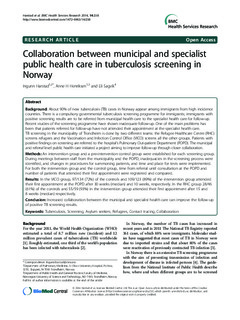| dc.contributor.author | Harstad, Ingunn | |
| dc.contributor.author | Henriksen, Anne Hildur | |
| dc.contributor.author | Sagvik, Eli | |
| dc.date.accessioned | 2015-09-11T11:50:30Z | |
| dc.date.accessioned | 2015-09-17T09:29:49Z | |
| dc.date.available | 2015-09-11T11:50:30Z | |
| dc.date.available | 2015-09-17T09:29:49Z | |
| dc.date.issued | 2014 | |
| dc.identifier.citation | BMC Health Services Research 2014, 14(1) | nb_NO |
| dc.identifier.issn | 1472-6963 | |
| dc.identifier.uri | http://hdl.handle.net/11250/300472 | |
| dc.description.abstract | Background: About 90% of new tuberculosis (TB) cases in Norway appear among immigrants from high incidence
countries. There is a compulsory governmental tuberculosis screening programme for immigrants; immigrants with
positive screening results are to be referred from municipal health care to the specialist health care for follow-up.
Recent studies of the screening programme have shown inadequate follow-up. One of the main problems has
been that patients referred for follow-up have not attended their appointment at the specialist health care.
TB screening in the municipality of Trondheim is done by two different teams: the Refugee Healthcare Centre (RHC)
screens refugees and the Vaccination and Infection Control Office (VICO) screens all the other groups. Patients with
positive findings on screening are referred to the hospital’s Pulmonary Out-patient Department (POPD). The municipal
and referral level public health care initiated a project aiming to improve follow-up through closer collaboration.
Methods: An intervention group and a pre-intervention control group were established for each screening group.
During meetings between staff from the municipality and the POPD, inadequacies in the screening process were
identified, and changes in procedures for summoning patients, and time and place for tests were implemented.
For both the intervention group and the control group, time from referral until consultation at the POPD and
number of patients that attended their first appointment were registered and compared.
Results: In the VICO group, 97/134 (72%) of the controls and 109/123 (89%) of the intervention group attended
their first appointment at the POPD after 30 weeks (median) and 10 weeks, respectively. In the RHC group 28/46
(61%) of the controls and 55/59 (93%) in the intervention group attended their first appointment after 15 and
8 weeks (median) respectively.
Conclusion: Increased collaboration between the municipal and specialist health care can improve the follow-up
of positive TB screening results.
Keywords: Tuberculosis, Screening, Asylum seekers, Refugees, Contact tracing, Collaboration. | nb_NO |
| dc.language.iso | eng | nb_NO |
| dc.publisher | BioMed Central | nb_NO |
| dc.title | Collaboration between municipal and specialist public health care in tuberculosis screening in Norway | nb_NO |
| dc.type | Journal article | nb_NO |
| dc.type | Peer reviewed | en_GB |
| dc.date.updated | 2015-09-11T11:50:30Z | |
| dc.source.volume | 14 | nb_NO |
| dc.source.journal | BMC Health Services Research | nb_NO |
| dc.source.issue | 1 | nb_NO |
| dc.identifier.doi | 10.1186/1472-6963-14-238 | |
| dc.identifier.cristin | 1164203 | |
| dc.description.localcode | © 2014 Harstad et al.; licensee BioMed Central Ltd. This is an Open Access article distributed under the terms of the Creative Commons Attribution License (http://creativecommons.org/licenses/by/2.0), which permits unrestricted use, distribution, and reproduction in any medium, provided the original work is properly credited. | nb_NO |
